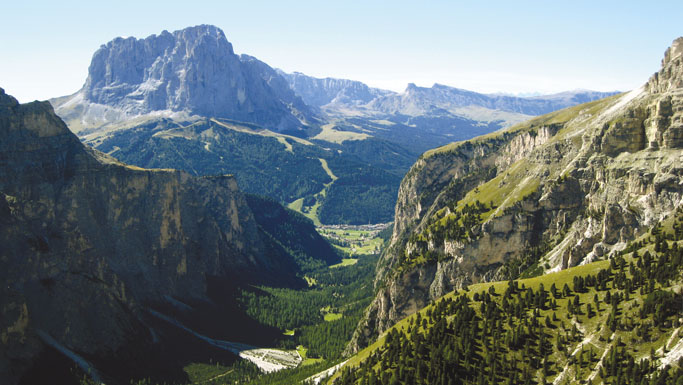Comprising over 90,000 acres of mountainous terrain, the Italian Dolomites offer a unique corner of the Alps with distinctive geology and a fascinating blend of cultures. Formed at the same time as the entire crescent of the Alps, the Dolomites are notable for their composition of pale colored dolomite– a limestone-like rock formed beneath deep, ancient seas– atop darker volcanic bedding. These fabulous vertical reefs glow in the changing light and present a startling and dramatic contrast to the pastoral beauty beneath.
History
Located to the south of the main chain of the Alps, the Dolomites are geographically and culturally at a crossroads between Italy to the south and Tyrol to the north. In the First Century, the Romans invaded the Alps and remnants of their culture, particularly in the Ladin speaking villages, still remains. Though the Dolomites have been almost exclusively an Italian possession since after World War I, the culture remains a blend of the Tyrolean, Rhaeto-Roman and Italian influences.
As you wander among the picturesque villages and rolling green pastures, you may notice a sturdy Italian Gothic tower and an onion-domed Tyrolean steeple vying for ascendancy with the looming walls of dolomite. In many places, evidence of the grueling battle between Italy and Austria is still highly visible. It is an irresistibly fascinating, beautiful and photogenic land.
The Dolomites Geography
Within the Dolomites exist a number of regions, including the pastoral and lovely Val Gardena with its Tyrolean flavor, the unique Val Badia, where over 90% of the population speaks Romansch as a first language, and the Ampezzo region, with its strong Italian character. This, the northern and eastern tier of the Dolomites is the heart of the range with access for hikers to the Sciliar, Rosengarten, Sassolungo, Puez, Sella and Tofane ranges.
Villages and Culture
The villages beneath are enchanting with their mix of culture and architecture. A number of villages have cobblestoned streets that wind around medieval churches. Surrounding each village, expansive pastures that are communally or cooperatively managed are farmed traditionally, with the cows moving to higher pastures, or alps, in the summer, while crops and hay for winter are gathered from the closer fields.
Both the annual rhythm of farming and the system of managing the pastures and forests date back to medieval times. The land has been protected from development, both voluntarily through primogeniture and legally through villages administering laws protecting land from the subdivision. In this way, not only is there assured enough fodder for farm animals and produce for the inhabitants, but the traditional landscape and way of life are preserved and enjoyed by all.
Tourism and Attractions
Today, and since the middle of the Nineteenth Century, tourism has complemented agriculture in these high, alpine valleys. A number of local crafts, most notably wood carving, have developed to supplement the hard life of high altitude farming, and today much of the economy is supported through tourism. Winter brings a strong ski industry, and summer brings hikers and other lovers of the mountains.
August is the typical summer holiday for Italians, many of whom will come to the Dolomites and spend one, two, or more weeks in one hotel. Others come and hike along the long distance Alta Via routes or scramble among the many airy, cabled and laddered Via Ferrate while bunking in rifugios.
An excellent trail and lift system is supported not only by hotels in the villages but by these simple, high altitude accommodations, some of which are very austere while others are quite well appointed.
Inns and Accommodations
Many comfortable and charming inns are attractions to visitors, and you will find everything from simple farmhouse accommodations, to inns filled with Tyrolean antiques and fascinating old edifices dating to medieval times. The cuisine is a blend of Italian, Tyrolean and alpine cuisine, all served alongside the many fine wines of the Alte Adige region.
Though a dish of bread, potatoes, pasta, cheese, and butter may have been a standard at the turn of the last century, today’s menus are tempered by the demands of the modern palate, and you will rarely now find all three starches combined in one dish!









Comments are closed.